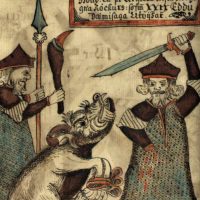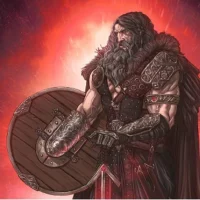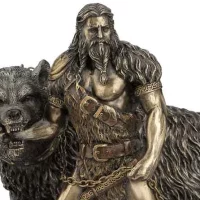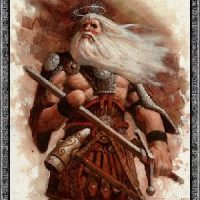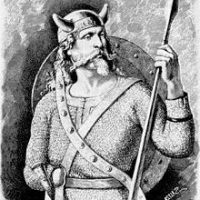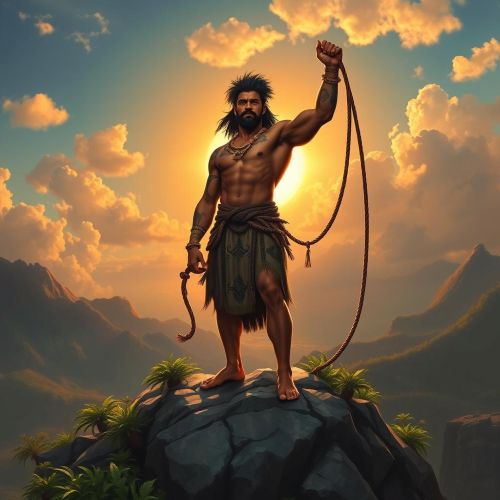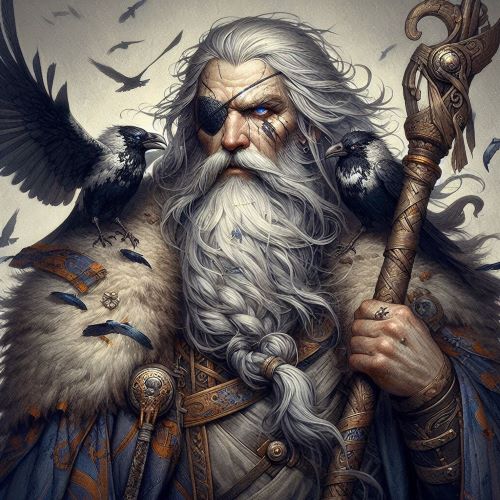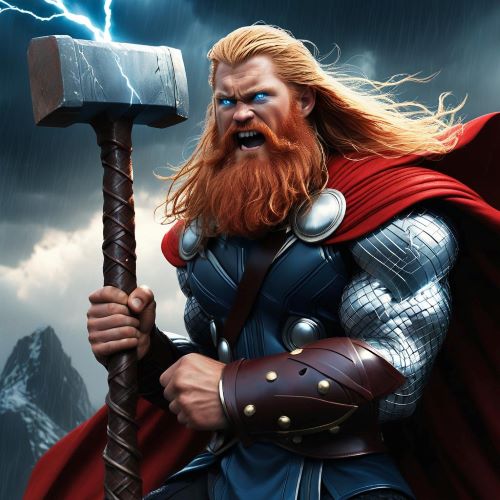Tyr : God of War
Listen
At a glance
| Description | |
|---|---|
| Origin | Norse Mythology |
| Classification | Gods |
| Family Members | Odin (Father) |
| Region | Iceland, Denmark, Norway, Finland |
| Associated With | War, Justice |
Tyr
Introduction
Tyr, the enigmatic one-handed god, occupies a significant place within Norse mythology as a formidable figure embodying courage, sacrifice, and righteousness. Unlike the flamboyant Odin or the mischievous Loki, Tyr embodies a stoic and principled nature, revered for his unwavering commitment to maintaining order and honor. Pronounced like the English word “tier,” Tyr is one of the oldest and most revered gods of the Norse and Germanic peoples, associated with war, law, and justice. Once the leader of the Aesir, the tribe of gods ruling over Asgard, Tyr’s position was later supplanted by Odin as the supreme god. Despite this, Tyr’s legacy as a symbol of bravery and moral authority endures throughout Norse mythology and beyond.
Physical Traits
Tyr’s depiction as a one-handed god stems from a tale in Norse mythology where he sacrifices his right hand to the monstrous wolf Fenrir, who severs it when realizing the gods’ attempt to bind him. Despite this physical sacrifice, Tyr retains his status as a powerful and valorous member of the Aesir. In artistic representations, Tyr is portrayed as a stalwart and imposing figure, exuding strength and determination befitting a god of war. He is often depicted wielding a sword or spear, symbols of his martial prowess and authority on the battlefield. Unlike many other Norse gods depicted with fantastical appearances, Tyr is presented as a human warrior, emphasizing his strength, bravery, and dignified demeanor. Notably, his most striking feature is the absence of his right hand, serving as a poignant reminder of his sacrifice for the greater good.
Family
Tyr’s parentage remains a subject of debate within Norse mythology, with conflicting accounts presented in different sources. The Poetic Edda, a collection of early poems, offers two contrasting narratives regarding his lineage. One account depicts Tyr as the son of Odin, the chief god of the Aesir tribe, while another suggests he is the offspring of the giant Hymir, aligning him with the Jotuns, traditional rivals of the Aesir. This ambiguity adds to the enigmatic nature of Tyr, leaving his origins open to interpretation.
Descriptions of Tyr vary across Old Norse sources, with some identifying him as the son of the jötunn Hymir and others attributing his parentage to the god Odin. The poem Lokasenna makes reference to an unnamed consort, further complicating Tyr’s familial background. Regardless of his parentage, Tyr is often associated with his siblings, including Thor, the god of thunder, and Baldr, the god of light and purity, highlighting his prominent place within the divine family tree.
Other names
Tyr, like many Norse deities, is known by various names and epithets that embody different aspects of his character and domain. Among these titles, he is frequently called the “One-handed” or “The Sacrificer,” alluding to the myth where he forfeits his hand to bind the monstrous wolf Fenrir. These epithets underscore Tyr’s courage, selflessness, and readiness to make personal sacrifices in the pursuit of justice and order. In Old English, Tyr is referred to as Tīw, while in Old High German, he is known as Ziu, both originating from the Proto-Germanic *Tīwaz, meaning ‘God’.
Additionally, the name of a Gothic deity, *Teiws (later *Tīus), is reconstructed based on the associated rune tyz. Tuesday, the second day of the week in many Germanic and Scandinavian languages, is named after Tyr, reflecting his association with war and battle, akin to the Roman god Mars, whose day is also Tuesday. Intriguingly, some scholars speculate that Tyr might have enjoyed wider worship in earlier Germanic cultures than Odin.
Powers and Abilities
Tyr stands as one of the principal war gods of Norse mythology, alongside Odin and Thor, a role well-documented in sources dating back to the Viking Age. For instance, in the Sigrdrífumál poem of the Poetic Edda, the valkyrie Sigrdrifa advises the hero Sigurd to invoke Tyr for success in battle. However, Tyr’s significance transcends mere warfare; his primary role appears to revolve around upholding law and justice. Despite the loss of his hand, Tyr’s reputation for strength and combat prowess remains unparalleled. Revered as a skilled strategist and fearless warrior, he earns respect from both gods and mortals alike.
Beyond his physical abilities, Tyr epitomizes the principles of law and justice within the Norse pantheon. He is recognized as a guardian of oaths and treaties, ensuring fairness and order among divine beings. Particularly notable is Tyr’s involvement in single combat, contrasting with the chaotic warfare often associated with war gods. His engagements emphasize honorable one-on-one battles that test courage and skill.
Tyr’s most renowned legend revolves around his encounter with the monstrous wolf Fenrir, foretold to bring about Ragnarok, the Norse apocalypse. When the gods attempted to bind Fenrir with magical chains, Tyr, displaying immense courage, offered his right hand as a gesture of trust. However, Fenrir, realizing the gods’ true intentions, bit off Tyr’s hand. Despite this sacrifice, Tyr’s bravery ensured Fenrir’s temporary containment, marking him forever as a symbol of valor and sacrifice.
As the god of war and justice, Tyr possesses a formidable array of powers and abilities that distinguish him from other divine beings. His unparalleled combat skills make him a fearsome adversary on the battlefield, while his unwavering commitment to justice underscores his moral authority among gods and mortals alike.
Modern Day Influence
Tyr’s impact extends into modern times, notably evident in the naming of Tuesday, derived from Old English “Day of Tiw (Tyr)” (Tiwesdæg), which traces back to the Latin Dies Martis, meaning “Day of Mars.” This association between Tyr and Tuesday underscores the lasting influence of this ancient Norse deity.
While originating in antiquity, Norse mythology maintains a profound presence in contemporary culture, with Tyr featuring prominently in various artistic mediums. From literature and cinema to video games and comics, Tyr’s portrayal as a noble warrior and champion of justice captivates audiences worldwide. His enduring legacy manifests in modern society, where his principles of courage, sacrifice, and honor resonate deeply with individuals seeking guidance and inspiration.
Despite not achieving the same level of recognition as Odin or Thor, Tyr continues to wield a subtle influence in the modern era. Beyond the connection to Tuesday, Tyr’s persona appears across diverse media, often depicted as a formidable warrior or symbol of justice. The archetype of Tyr as a one-handed fighter who upholds law and honorable combat strikes a chord with contemporary audiences valuing bravery and selflessness.
Related Images
Frequently Asked Questions
What was Tyr the god of?
Tyr, a Norse god, embodied complex ideas. He wasn’t just a violent war god, but one of honor, law, and justice in battle. Associated with treaties and assemblies, he was also a champion of heroes and their deeds. Famously one-handed, Tyr sacrificed his hand to bind a monstrous wolf, showing his bravery and commitment to order.
Is Tyr a son of Odin?
Norse myths on Tyr’s dad differ. Some tales say Odin, the Allfather, is his father. Others claim the giant Hymir sired him. Despite his lineage, Tyr championed law, war with honor, and heroes.
Who killed Tyr in Norse mythology?
In Norse mythology, Tyr isn’t actually killed before Ragnarok, the end of the world. He’s prophesied to be devoured by the monstrous dog Garm during that epic battle.
Are Tyr and Thor the same?
While both Norse gods of war, Tyr and Thor differ greatly. Tyr represents honor, law, and justice in battle, even losing a hand for order. Thor, the thunderous protector, crushes foes with his mighty hammer Mjolnir.
Why did Odin hate Tyr?
There isn’t any evidence in traditional Norse mythology that Odin hated Tyr. In fact, they seem to have coexisted as fellow Aesir gods. It’s possible you’re thinking of a modern portrayal, like the video game God of War Ragnarok, where Odin takes on Tyr’s identity for a specific purpose.


